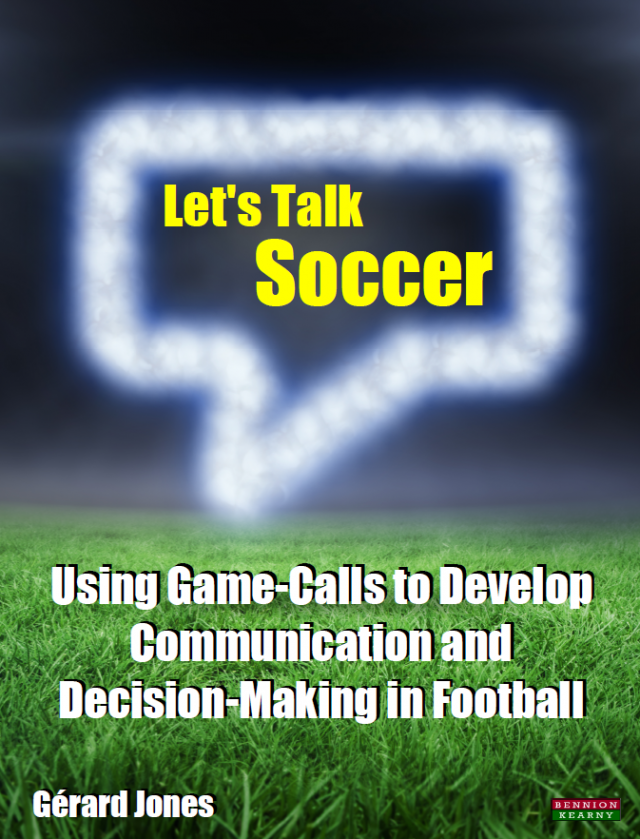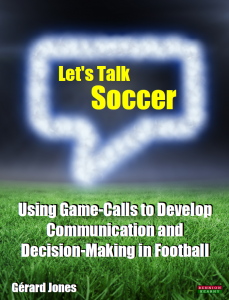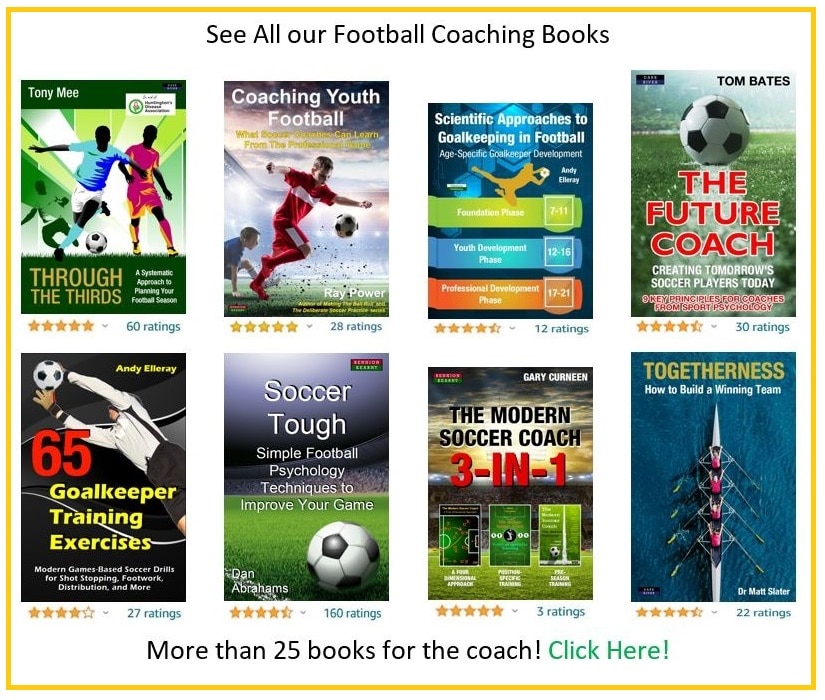An excerpt from:
![]()
Click on the cover to learn more
*
When working with a player today, prepare them for the game of tomorrow.
Often in education, like in the coaching of sports, we only prepare the learner based on the world of today… not tomorrow. The danger is that when the learner arrives in the world of tomorrow they find it difficult to adapt and perform at the required level due to how different the world has become. Does this sound familiar in soccer? Certainly! We often see certain groups of players coming through our academies who are failing to impact on the world of tomorrow. What is the solution? Do not prepare players based on what the world (in this case the game of football) looks like now, prepare them for where you think it will be in the future!
As discussed in Chapter 8, it would not be a complete surprise if soccer players in the future are so technically and tactically flexible that they become almost positionless in the sense that they may start playing in one position and finish in another. The player of the future will almost certainly be so highly skilled that they can adapt to any shape and formation the opposition play, and the team they represent starts with. As the game progresses it may be the players who shift the system into one that cannot be easily recognised as the conventional 1-4-4-2 or 1-5-3-2.
*
Are you a soccer coach? We have more than 25 titles currently available.
Over recent years, the game has become much faster, and players are quicker when compared to previous years. Most players are more technically efficient, they can occupy more roles, and as a result of their increased levels of technical excellence they are able to use their feet to control and manipulate the ball under high degrees of opponent pressure across all positions on the pitch.
Past generations saw traditional defenders as players who perhaps were not the greatest on the ball technically, but were good in the air and could tackle and use their bodies well. Now defenders, such as centre backs, have to be technically competent in order to retain possession when playing out from their goalkeepers, receiving passes across the back and from midfield, alongside the ability to step into midfield to overload central areas. Even full backs are more attacking, with higher starting positions than before; they are often occupied as additional wingers in the modern game.
The game has seen areas such as power, speed and endurance become key factors in the requirements for the modern (and future) player, with the ball moving to and from players at quicker speeds than before. As a result, teams are keeping possession of the ball for longer periods. All of this information is not new information… so what are the implications for the future player?
Future players will undoubtedly be good learners, intelligent, and with excellent professional attitudes, as they will need to able to understand the importance of the first and second pass that allows their team to keep possession. Remember possession is our best defender, so with this in mind, players will create more passing and receiving situations where the ability to play with few touches will be a pre-requisite to play at the highest level. As a result, more teams will become universal in the sense that passing retention will increase and there will be an increased demand for skilful dribblers.
As a result of teams being technically and tactically efficient, and athletically strong, opposition teams will have the challenge of ‘patience’ when defending (as opposed to an all-out high press, all the time). The ability to regain possession from clever interceptions and one versus one tackling will be of paramount importance as team defending will need to anticipate and respond better to the opposition’s increased levels of possession.
Continuing the universal positionless theme – does the game of tomorrow mean that there will be no real experts in one role? Perhaps, although certain players will still have strengths and preferences towards set positions. This may mean that as positions interchange, players will revert back to their desired position – one that meets their strengths and preferences. This may not be the original position they started out in, of course. This will help teams become unorthodox and unpredictable.
The most important consideration for coaches is that the game will become fluid with players’ movement so fast and interchangeable that it becomes increasingly hard for opposition teams to track runners and identify opposition strengths and weaknesses. Matt Whitehouse’s recent book Universality expands upon Dick Bate and Arrigo Sacchi’s findings on how much the game has changed over the years, such that: “The future will not just be a team-centred game, but a universal game where players require positional freedom and variability to interchange where required.”
Some will argue that these claims, like the one suggested in Chapter 8, are false, and suggest that no team that can play all positions will be able to win soccer matches (“Jack of all trades, master of none”). Despite the debate, we are certain that players will need to be comfortable in demanding and governing the ball. They will need to demonstrate game-intelligence and have excellent aerial and ground ability when attacking and defending balls using all body parts.
How does this impact on your coaching? You will need to encourage game understanding through the use of game-calls, and allow players to play in a range of positions both during games and in training. In a nutshell, you will need to encourage flexibility. There is a case that expertise comes from specialising players into set positions early. I would however argue against this. There have been numerous elite players in the game who have started in one position, and finished in another. Take Jamie Carragher, ex England international and Liverpool defender, who started off as a forward and finished his playing career as a defender. In the early years of his career, Steven Gerrard, ex England international and Liverpool legend was played as a right back and right midfield before becoming a central midfielder and later a holding midfield player. The key message, therefore, is to encourage players to learn the game by playing the game.
Power of self-learners
In order to become well trained in the use of game-calls, and in the game of soccer as a whole, players will need to become excellent self-learners. This means that they take responsibility for their learning and reflect more on not just what the coach has said but how they interpret their own performance, as well as the areas they feel they need to strengthen and address.
Becoming a great self-learner is a key trait that separates top performers from average ones. The players who can instantly take feedback from significant others and themselves on-board, and act on the feedback to improve their performance, will be players who have the greatest success.
We currently know that most learners in groups can be categorised into three groups: those at the top who are pushing forward, those in the middle who are getting by (and trying to keep up with the top crop of learners). And, finally, those at the bottom who are struggling to keep up with everyone. These different groups, as discussed, will emerge from any chosen task and will require different individual challenges.
This global assessment masks the truth behind personal learning. Some players may be bottom of the group in terms of their social learning of game-calls but at the top of the group in terms of their tactical understanding of the game. This is where becoming a good self-learner will allow this player to figure out what they need to do to address their inadequacies.
The problem in the past has been that players struggle to self-diagnose their barriers to learning and rely on feedback from their coaches solely. A player who lacks the ability to self-analyse and correct will struggle to adapt to changing environments. This is where it is vital that coaches try to develop responsibility (during training sessions and in games) in players.
Self-learning is guided by metacognition meaning how one thinks about one’s own thoughts. The power of thinking about their thoughts will allow players to develop strategic knowledge, which is what the theory of game-calls is based on (see Chapter 7). Players who are self-learners will plan, monitor and evaluate their personal progress better than those who cannot.
The best players in the world are the best self-learners – and inspire others by their actions.
Tone
The tone of how a coach says a particular game-call to a player, and how the player in turn says a game-call to a teammate, will influence the recipient of the information differently each time the word or phrase is used. For example, if a goalkeeper always screams his game-calls aggressively to his defence as “AWAY!” and “PRESS!” with a strong tone and volume, he may subsequently find himself in a situation that requires the players to react more urgently and quickly than normal. But because he is always ‘loud and urgent’ teammates listening to the call won’t be able to determine any difference in the situation.
When I say “Show Away” calmly to one of my teammates, they will notice a difference in my voice compared to if I say “SHOW AWAY!” more loudly, with more duration, and perhaps an air of nervousness in my voice. This will trigger a different reaction from the players physiologically and therefore they might react more quickly and aggressively themselves. Basically, the tone suggests to the player that this is a more stressful situation that requires more urgent attention.
Many coaches, however, often have a teaching style which involves the same tone, speed of speech, volume and frequency of words… regardless of the situation. As a result, players will not be able to differentiate when a coach is calm, or nervous, or being serious, or joking.
The ability to manipulate tone, volume and speed of speech will become a future requirement of both the coach and player.
Taking ownership
Players who are accountable for their actions and take responsibility for their decisions become better decision-makers long term and better learners. Players who do not take ownership in the sense of wanting to learn from mistakes, practice more, or be accountable for their decisions, are the ones that will never reach their full potential as they will forever play it safe for fear of being criticised.
This is not to say that coaches can lay the blame on players for making mistakes. Good coaches are ones that are not afraid to say: “I take responsibility for this. I tried it and it didn’t work and that was my decision.” This is hugely powerful to players as it shows we are all human.
Reflection – self-talk
Players will become increasingly effective at listening to their inner voice in the future. This is what will guide them to make better instantaneous decisions. Using game-calls regularly, you will find that players will train their minds to think deeply and articulate what they see. Therefore, when they reach the stage of transcendence, as described earlier in the book, they will have this inner voice screaming the game-call to them, without them having to say it out loud. They will talk themselves through the game by recognising the triggers for when to press, when to drop, when to play quickly, and so on.
Within this will come the ability to talk positively about their perceptions and experiences of how well the game is going. Equally, players will be able to control their inner emotions to remain in a positive state of mind and deal with negative scenarios that occur during the game. The ability to have strong emotional control and not lose control over incidents involving disagreement, aggression, challenge, adversity or confrontation will become a required skill of the future player.
Positive self-talk and reflection will become an intrinsic motivational tool for players, as they will use their reflections and talk during the game, to inspire their actions. This is one of the benefits of self-talk/reflection. Often coaches think about how to motivate their players. The player of the future will be a good self-motivator as a result of the self-talk and reflection. The challenge for coaches will be how to get a little extra from the players. The greatest coaches manage to get that little bit more from players who are already motivated to learn and perform. They achieve this by encouraging them to think deeper about their performance (reflection) and the action their thoughts towards a higher level of performance.
Football homework
The player of the future will undoubtedly engage in football homework, meaning specific practice to aid their learning. Some coaches may feel that if we start giving football homework to players, we are giving them too much as they already have a lot to do and think about (especially if still at school or university). I would disagree – there is still a place for homework.
In the past, I have asked junior and senior players to watch a game of their choice and identify key things a player in their position does. In my experience, some players completed the task, others say they forgot, and some clearly did it on the way to the session at the last minute. The learning from such an exercise is not always as good as intended! A powerful and successful method I have used includes setting substitutes tasks to watch certain aspects of the opposition’s play, which they can then feedback to players or just me. I have asked players to feedback to players at intervals when they felt the opposition was weak, and who was causing us a problem on the opposition team.
Each of these methods allows players to think more about the game and learn through study. Another way of setting football homework can be to harness social communications via email, such as emailing a player an image of a situation from a game and getting them to comment on it.
Players, in general, are visual learners, so find ways of tapping into this by giving them homework where they have to reflect on what they have observed. Make it relevant to the player, for example a player who is struggling with driving and sliding may need a video or the coach to point out when this occurs successfully during a game in order to learn the skill. The homework could be used to identify when this skill is used in a game and why.
The power of influence
Without doubt, the parent has the most influence on a player’s life. As the coach you want this influence to be positive and supportive of the player’s learning journey. One way of tapping into this, is to set parents some football homework that is specific to their child. Knowing that one player may need to work on his ability to track runners, I would ask the parent to make a note of how many times his son successful tracked his runner, including the number of total attempts. This could be done over a few weeks. It offers evidence to support any assessment I make on the player’s progress and develops a specific conversation on the way home between the player and parent geared around the player’s learning. It is also another example of how to make a player feel special, which is the key to getting buy-in from a player. Players will be more inclined to do homework if they feel you care and there is a long-term benefit in them doing so. This is particularly relevant when working with young players.
Naturally, players seek validation on how well they are doing. Some need this from the coach, others only need it from themselves. In order to make sure validation is achieved, you need to make an effort to understand the individual and show you care. Once this is achieved, the player will always buy into what you want from them.
Find out who that ‘significant other’ is in a player’s life. It may not be a parent, it may be their friend or mentor, or a loved one. Whoever it is, ask them to help and more often than not they will.
The role of purposeful language
Often the importance of how a coach phrases his sentences is neglected in coach education, and yet is a fine detail which we need to facilitate and maintain player learning. Once a coach has started on his coach education journey, he is immediately experimenting with the skill of how to improve feedback to players. One way to improve feedback is through purposeful language. What is this? It is language that has a specific aim: to meet the need of the individual and how they learn!
Often I see coaches give feedback to players, irrespective of their preferred learning style. (In fact, I have fallen into this trap, before). When working with an Under-14 player, in particular, I would stop the player to demonstrate the situation to him. I soon realised that this player did not respond well to being stopped as he felt he had made a mistake.
It was only when I asked myself “What is this player’s individual learning style?” that I decided not to stop him during an activity. Instead, as the game or practice went on, I simply stood next to him and asked him a question about what I had seen. This made a massive difference as the questions/feedback I offered related to the game-calls we used; the player listened to what I asked rather than ignoring it.
Purposeful language goes even further. The coach who is focussed on improving learning needs to use specific phrases and ways of saying phrases in line with the preferred learning style of a player.
When supporting players through game-calls, find out what their preferred learning style is. In other words, do they prefer to learn by seeing the action (Visual), do they prefer to feel and experience the action by doing it (Kinaesthetic), or do they learn better by listening and being asked a question (Auditory)? Some players will prefer to see words written down so that they can read and reflect upon themes, or even write the words themselves.
Depending on the context of learning, each player will prefer to learn in any of these ways, hence the reason for using the word “preferred” and not setting a learning style. This is vital when intervening with players as you need to know in what situations they prefer to be asked a question rather than shown (or told).
For Visual learners: your purposeful language may be: What does Start-again look like? or Do you see what I mean?
For Auditory learners: your purposeful language may be:What is the difference between when I say Press and PRESS!? or How does Play-round sound during a game? Have we spoken about this before?
For learners who prefer to Read/Write: your purposeful language may be:How does this read to you? or what do you think when you read Start-again? Or even Write down key points you need to think about when Starting-again.
For the preferred Kinaesthetic learners: your purposeful language may be:Are you comfortable with that? How does that feel? Have we touched on this already?
When giving feedback, notice the importance of And and But in your vocabulary. For example, using the word ‘but’ automatically cancels out the previous part of any statement (e.g. “you did this well but you still need to….”). This is not purposeful feedback and instead offers a negative perspective on the performance. Rather than using ‘but’ in your vocabulary try to use the word and more.
For example, “You did well there in using your body shape to receive when under pressure, and with the use of your arms, you’ll have great balance to hold the defender off….” Rather than, “you did well there in using your body shape but you still need to use your arms more….” See the difference?
When coaching players, be clear about what you are asking from them. Often in coaching we use the phrase “Can you?” or “Try to”. For example, “Can you show me when you would use the word Start-again?” or “Try to show me when to Start-again”.
These phrases are fine when opening learning possibilities at first. As you start to develop the understanding around using Start-again and other game-calls, replace the phrase “Can you?” or “Try to” with a clear outcome sentence: “In this game demonstrate when to use Start-again to keep possession of the ball.” This way your language is no longer a request. Offering purposeful, clear expectations allows learning objectives to be clear from the start. This goes even further. It is important that you develop high level thinking skills in your players, and not low level ones. For example, words such as “Who?” or “Can you…” and “How” are good words for recalling knowledge and regurgitating facts without understanding. These words simply require low level thinking to answer a question, which over time will train your players to think at a lower level.
If you want high level thinking skills, you need to use words such as “Why” or “Debate”, “Explain”, and even “Identify”. For example, “Explain how this would….” You are encouraging players to evaluate and therefore justify their arguments and opinions.
The player of the future needs to be enthused by coaches who are excellent communicators.
Just by making a simple change to the language you use, when talking to your players, can make significant differences in how motivated and enthused by any session your players will be. It will also change how you get your players to think, whether that is just recalling knowledge, testing comprehension and application, or using specific words that encourage players to analyse, compare and evaluate.
Summary
This chapter is very much about final thoughts that feed into designing and developing game-calls.
It is vital that a coach knows the requirements for developing a player for the game of tomorrow and not today! There is no point in setting off on a journey if you do not have an idea of where you are going and what will happen when you get there.
The importance of being a self-learner is the key to future success. This only comes from allowing your players to take more ownership in their learning and reflecting on their experiences through specific football homework you set them and (hopefully) a significant other. With this comes the ability to manipulate tone, speed of speech, and volume, which will be essential requirements when influencing teammates and players.
The value of specific words is paramount to establishing high level thinking or low level thinking in your players. Try to ask questions that encourage your players to evaluate and compare instead of simply regurgitating knowledge to you. Thinking footballers are the key to success!
The next chapter will discuss how to put all of this together into your own language.




